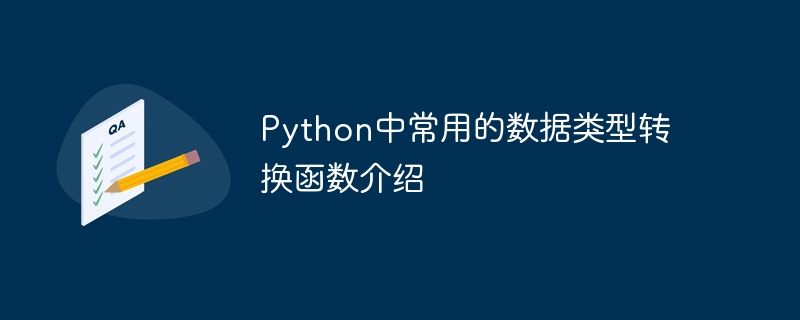Home >Backend Development >Python Tutorial >Introducing common Python data type conversion functions
Introducing common Python data type conversion functions
- 王林Original
- 2024-01-20 09:04:061471browse

Introduction to commonly used data type conversion functions in Python
In the Python programming language, data type conversion is a common and important operation. Through data type conversion, we can convert a data object from one type to another, allowing us to process different types of data more flexibly. This article will introduce commonly used data type conversion functions in Python and provide specific code examples.
- int() function
int() function is used to convert a given data object to an integer (int) data type. It can handle different types of data such as strings and floating point numbers, and convert them into corresponding integer types.
Sample code:
num1 = "10" num2 = 3.5 num3 = 7.8 result1 = int(num1) result2 = int(num2) result3 = int(num3) print(result1) # 输出结果为 10 print(result2) # 输出结果为 3 print(result3) # 输出结果为 7
- float() function
float() function is used to convert a given data object to floating point (float) data type. It can handle different types of data such as integers and strings, and convert them into corresponding floating point types.
Sample code:
num1 = 10 num2 = "3.5" num3 = "7.8" result1 = float(num1) result2 = float(num2) result3 = float(num3) print(result1) # 输出结果为 10.0 print(result2) # 输出结果为 3.5 print(result3) # 输出结果为 7.8
- str() function
str() function is used to convert the given data object to the string (str) data type . It can handle different types of data such as integer and floating point types, and convert them into corresponding strings.
Sample code:
num1 = 10 num2 = 3.5 result1 = str(num1) result2 = str(num2) print(result1) # 输出结果为 "10" print(result2) # 输出结果为 "3.5"
- list() function
list() function is used to convert a given data object to a list (list) data type. It can handle different types of data such as strings, tuples, and sets, and convert them into corresponding lists.
Sample code:
str1 = "Hello, World!"
tuple1 = (1, 2, 3, 4, 5)
set1 = {1, 2, 3, 4, 5}
result1 = list(str1)
result2 = list(tuple1)
result3 = list(set1)
print(result1) # 输出结果为 ['H', 'e', 'l', 'l', 'o', ',', ' ', 'W', 'o', 'r', 'l', 'd', '!']
print(result2) # 输出结果为 [1, 2, 3, 4, 5]
print(result3) # 输出结果为 [1, 2, 3, 4, 5]- tuple() function
tuple() function is used to convert a given data object to a tuple data type . It can process different types of data such as strings, lists, sets, etc., and convert them into corresponding tuples.
Sample code:
str1 = "Hello, World!"
list1 = [1, 2, 3, 4, 5]
set1 = {1, 2, 3, 4, 5}
result1 = tuple(str1)
result2 = tuple(list1)
result3 = tuple(set1)
print(result1) # 输出结果为 ('H', 'e', 'l', 'l', 'o', ',', ' ', 'W', 'o', 'r', 'l', 'd', '!')
print(result2) # 输出结果为 (1, 2, 3, 4, 5)
print(result3) # 输出结果为 (1, 2, 3, 4, 5)Summary:
This article introduces commonly used data type conversion functions in Python and their specific code examples. By using these functions, we can flexibly convert between different types of data and adapt the data to the data type we need. Mastering the use of these functions is of great help in daily programming work.
The above is the detailed content of Introducing common Python data type conversion functions. For more information, please follow other related articles on the PHP Chinese website!

